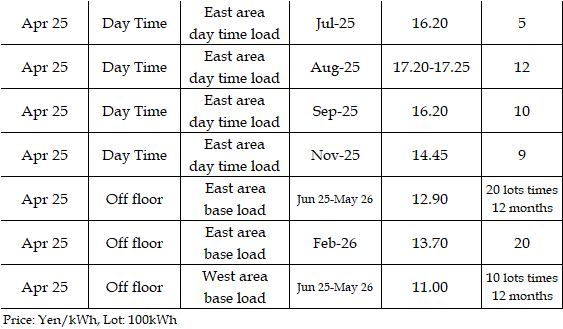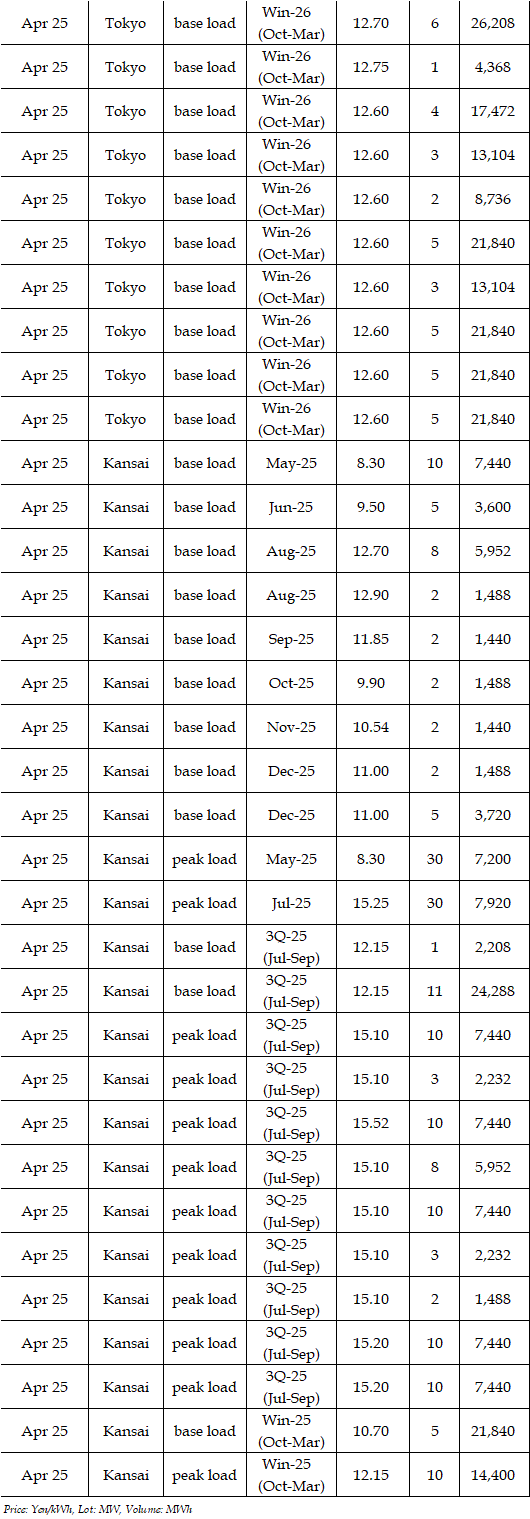|
In the day-ahead market on JEPX (Japan Electric Power Exchange), the 24-hour spot power prices on a weekly average basis for Apr 21-25 delivery bounced back from the previous week in both East Japan (50Hz) and West Japan (60Hz). The weather turned cloudy more frequently than the previous week, and a decrease in solar power supply lifted spot prices led by midday hours. But the temperatures rose to mild levels amid typical spring climate, and a slowdown in both air-conditioning and heating demand put a lid on spot prices.
In Tokyo and Kansai, the key areas in East Japan and West Japan, the 24-hour average posted a difference in favor of the East by Yen 1.77 for Apr 21 delivery, Yen 0.82 for Apr 22 delivery, Yen 0.52 for Apr 23 delivery, Yen 2.92 for Apr 24 delivery and Yen 1.97 for Apr 25 delivery.
The fuel market trends in the fourth week of April were detailed as follows.
DES Northeast Asia spot LNG prices weakened to the mid $11 level per mmBtu for prompt June 2025 arrival as of Apr 24, down about 25cts from the end of the previous week (Apr 18). LNG prices firmed up in the first half of the week on the back of production outages at several projects. But the market erased early gains in the latter half of the week in line with a softness in European natural gas prices. The production troubles were found to be relatively minor. The Ministry of Economy, Trade and Industry (METI) announced on Apr 23 that Japan's LNG inventories for power generation stood at 2.11 mil mt as of Apr 20, down 20,000mt from a week before. The figure was down both from 2.18 mil mt as of end-April last year and the average of past five years at 2.14 mil mt.
FOB Newcastle thermal coal prices in Australia stood in the high $93 level per ton for April 2025 loading as of Apr 24. The level was down more than $1 from the end of the previous week. The decline mirrored a softness in gas prices.
In the crude oil market, WTI crude for June 2025 stood in the low $63 level per barrel as of Apr 25 morning while Brent crude for June 2025 was trading in the high $66 level. Both WTI and Brent were down about $1 from the end of the previous week. Crude futures wobbled throughout the week as bullish and bearish factors played a tug of war. The market found support from a weaker dollar and sanctions against Iran. But some members of the Organization of the Petroleum Exporting Countries (OPEC) and non-OPEC producers, or OPEC plus, showed readiness to beef up output hikes in June, generating downside pressure on crude futures.
The actual highest price during the week was at Yen 20.30 in all of nine areas and the System Price (SP) for Apr 23 delivery. Meanwhile, the actual lowest price during the week was at Yen 0.01 in eight areas except Tokyo and SP for Apr 21 delivery, Hokkaido and Tohoku for Apr 22 delivery, four areas including Kansai, Chugoku, Shikoku and Kyushu for Apr 24 delivery, and Hokkaido and Tohoku for Apr 25 delivery.
By area, the weekly average of the 24-hour spot prices was at Yen 9.29 in Hokkaido, up Yen 0.34 from the previous week, Yen 10.05 in Tohoku, up Yen 0.98, Yen 11.30 in Tokyo, up Yen 0.71, Yen 10.39 in Chubu, up Yen 0.67, Yen 9.93 in Hokuriku, up Yen 0.42, Yen 9.77 in Kansai, up Yen 0.30, Yen 9.69 in Chugoku, up Yen 0.22, Yen 9.20 in Shikoku, down Yen 0.06, and Yen 9.10 in Kyushu, up Yen 0.57.
In the JEPX auction, volumes of offers were 1,110.46 mil kWh on a weekly average basis, up 0.2% from the previous week. Meanwhile, bids on a weekly average basis increased by 1.5% to 874.60 mil kWh. The weekly average of trade volumes decreased by 0.6% to 703.54 mil kWh.
Power demand in nine areas of Japan during Apr 21-25 was a combined 10,185.50 mil kWh, down 4.0% from 10,605.22 mil kWh during Apr 14-18. The figure was down 1.1% from the corresponding period a year earlier. Demand during Apr 22-26, 2024 after day of week adjustment was 10,298.63 mil kWh.
Deals reported on TOCOM (Tokyo Commodity Exchange) during Apr 21-25 were as below.


Deals reported on EEX (European Energy Exchange) during Apr 21-25 were as below.









In the final week of April and the first week of May, spot prices are expected to remain weak. During the first half of the Golden Week holidays, the weather is forecast to be favorable and ample solar power supply can be expected. Thus, a supply glut is likely to push down spot prices to Yen 0.01 in a series of midday windows, especially in Kyushu, Shikoku and Chugoku in West Japan mostly during the week. A source at a power producer and supplier pointed out, "Led by Kyushu with a high reliance on photovoltaic generation, power producers are believed to minimize thermal unit runs. Thus, spot prices may resist downside pressure after solar power suppl peaks out in evening and night time. As a result, the price gap for midday hours against evening and night time will likely widen." The source added, "Still, the 24-hour average in East Japan will fall below Yen 10 mostly during the week. I believe West Japan will underperform East Japan by Yen 2 or so."
|
JEPX: System Price (Day Ahead 24 hours)
|
|
Weekday Price
|
21-Apr
|
22-Apr
|
23-Apr
|
24-Apr
|
25-Apr
|
|
24-Hour Ave
|
7.55
|
10.02
|
12.86
|
9.47
|
10.12
|
|
Volume (MWh)
|
729,406
|
716,383
|
669,191
|
706,508
|
696,217
|
|
(unit: yen per kWh) (date: delivery day)
|
|
|

|